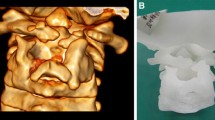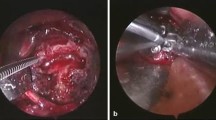Abstract
The aim of this study is to evaluate the first results of the atlantoaxial fixation using polyaxial screw–rod system. Twenty-eight patients followed-up 12–29 months (average 17.1 months) were included in this study. The average age was 59.5 years (range 23–89 years). The atlantoaxial fusion was employed in 20 patients for an acute injury to the upper cervical spine, in 1 patient with rheumatoid arthritis for atlantoaxial vertical instability, in 1 patient for C1–C2 osteoarthritis, in 2 patients for malunion of the fractured dens. Temporary fixation was applied in two patients for type III displaced fractures of the dens and in two patients for the atlantoaxial rotatory dislocation. Retrospectively, we evaluated operative time, intraoperative bleeding and the interval of X-ray exposure. The resulting condition was subjectively evaluated by patients. We evaluated also the placement, direction and length of the screws. Fusion or stability in the temporary fixation was evaluated on radiographs taken at 3, 6, 12 weeks and 6 and 12 months after the surgery. As concerns complications, intraoperatively we monitored injury of the nerve structures and the vertebral artery. Monitoring of postoperative complications was focused on delayed healing of the wound, breaking or loosening of screws and development of malunion. Operative time ranged from 35 to 155 min, (average 83 min). Intraoperative blood loss ranged from 50 to 1,500 ml (average 540 ml). The image intensifier was used for a period of 24 s to 2 min 36 s (average 1 min 6 s). Within the postoperative evaluation, four patients complained of paresthesia in the region innervated by the greater occipital nerve. A total of 56 screws were inserted into C1, their length ranged from 26 to 34 mm (average, 30.8 mm). All screws were positioned correctly in the C1 lateral mass. Another 56 screws were inserted into C2. Their length ranged from 28 to 36 mm (average 31.4 mm). Three screws were malpositioned: one screw perforated the spinal canal and two screws protruded into the vertebral artery canal. C1–C2 stability was achieved in all patients 12 weeks after the surgery. No clinically manifested injury of the vertebral artery or nerve structures was observed in any of these cases. As for postoperative complications, we recorded wound dehiscence in one patient. The Harms C1–C2 fixation is a very effective method of stabilizing the atlantoaxial complex. The possibility of a temporary fixation without damage to the atlantoaxial joints and of reduction after the screws and rods had been inserted is quite unique.

Similar content being viewed by others
References
Anderson LD, D’Alonzo RT (1974) Fractures of the odontoid process of the axis. J Bone Joint Surg 56-A:1663–1674
Brooks AL, Jenkins EW (1978) Atlanto-axial arthrodesis by the wedge compression method. J Bone Joint Surg 60-A:279–284
Dickman CA, Sonntag VK (1998) Posterior C1–C2 screw fixation for atlantoaxial arthrodesis. Neurosurgery 43:275–280
Eleraky MA, Masferrer R, Sonntag VK (1998) Posterior atlantoaxial facet screw fixation in rheumatoid arthritis. J Neurosurg 89:8–12
Farey ID, Nadkarni S, Smith N (1999) Modified Gallie technique versus transarticular screw fixation in C1–C2 fusion. Clin Orthop 359:126–135
Frankel HL, Hancock DO, Hyslop G (1969) The value of postural reduction in the initial management of closed injuries of the spine with paraplegia and tetraplegia. Paraplegia 7:179–192
Gallie WE (1939) Fractures and dislocations of the cervical spine. Am J Surg 46:495–499
Gebhard JS, Schimmer RC, Jeanneret B (1998) Safety and accuracy of transarticular screw fixation C1–C2 using an aiming device. An anatomic study. Spine 23:2185–2189
Gehweiler JA, Osborn RL, Becker RF (1980) The radiology of the vertebral trauma. Saunders, Philadelphia
Goel A, Leheri V (1994) Plate and screw fixation for atlanto-axial subluxation. Acta Neurochir 129:47–53
Goel A, Desai KI, Muzumdar DP (2002) Atlantoaxial fixation plate and screw method: a report of 160 treated patients. Neurosurgery 51:1351–1356
Greene KA, Dickman CA, Marciano FF, Drabier JB, Hadley MN, Sonntag VK (1997) Acute axis fractures. analysis of management and outcome in 340 consecutive cases. Spine 22:1843–1852
Grob D, Jeanneret B, Aebi M, Markwalder TM (1991) Atlanto-axial fusion with transarticular screw fixation. J Bone Joint Surg 73-B:972–976
Grob D, Crisco J, Panjabi M, Dvorak J (1992) Biomechanical evaluation of four different posterior atlanto-axial fixation techniques. Spine 17:480–490
Harms J, Melcher PR (2001) Posterior C1–C2 fusion with polyaxial screw and rod fixation. Spine 26:2467–2471
Jeanneret B, Magerl F (1992) Primary posterior fusion C 1/2 in odontoid fractures: indications, technique, and results of transarticular screw fixation. J Spinal Disord 4:464–475
Jeanneret B (1994) Posterior transarticular screw fixation of C1–C2. Tech Orthop 1:49–59
Jefferson G (1920) Fracture of the atlas vertebra. Report of four cases and review of those previously recorded. Br J Surg 7:407–422
Judet R, Roy-Camille R, Saillant G (1970) Fractures du raches cervical. Actualités de chirurgie orthopédique de l’hospital Raymond. Poinscaré 8:174–175
Lu J, Ebraheim NA, Yang H, Heck BE, Yeasting RA (1998) Anatomic considerations of anterior transarticular screw fixation for atlantoaxial instability. Spine 23:1229–1235
Magerl F, Seemann PS (1987) Stable posterior fusion of the atlas and axis by transarticular screw fixation. In: Kehr P, Weidner A (eds) Cervical spine.Springer, Wien, pp 322–327
Madawi AA, Casey AT, Solanki GA, Veres R, Crockard HA (1997) Radiological and anatomical evaluation of the atlantoaxial transarticular screw fixation technique. J Neurosurg 86:961–968
Melcher RP, Puttlitz CM, Kleinstueck FS, Lotz JC, Harms J, Bradford DS (2002) Biomechanical testing of atlantoaxial fixation techniques. Spine 27:2435–2440
Mitchell TC, Sadasivan KK, Ogden AL, Mayeux RH, Mukherjee DP, Albright JA (1999) Biomechanical study of atlantoaxial arthrodesis: transarticular screw fixation versus modified Brooks posterior Wiring. J Orthop Trauma 13:483–489
Naderi S, Crawford NR, Song GS, Sonntag VK, Dickman CA (1998) Biomechanical comparison of C1–C2 posterior fixation. Cable, graft and screw combinations. Spine 23:1946-1955
Resnick DK, Benzel EC (2002) C1–C2 pedicle screw fixation with rigid cantilever beam contruct: case report and technical note. Neurosurgery 50:426–428
Simmons EH, Du Toit G (1978) Lateral atlantoaxial arthrodesis. Orthop Clin N Am 9:1101–1114
Suchomel P, Štulik J, Klezl Z, Chrobok J, Lukas R, Krbec M (2004) Atlantoaxial transarticular fixation: multicentric retrospective study. Acta Chir Orthop Traumatol Čech 71(1):6–12
Stulik J, Krbec M (2000) Magerl’s technique of C1–C2 Fixation. Acta Chir Orthop Traumatol Čech 67/2:93–99
Stulik J, Krbec M, Havranek P (2002a) Marginal indication for Magerl fixation of C1–C2 (case report). Acta Chir Orthop Traumatol Čech 69/2:108–112
Stulik J, Suchomel P, Lukas R, Chrobok J, Klezl Z, Taller S, Krbec M (2002b) Direct ostesynthesis of odontoid process: a multicentre study. Acta Chir Orthop Traumatol Čech 69/3:141–148
Stulik J, Vyskocil T, Sebesta P, Kryl J (2005) Harms technique of C1–C2 fixation with polyaxial screws and rods. Acta Chir Orthop Traumatol Čech 72:22–27
Vaccaro AR, Lehman AP, Ahlgren BD, Garfin SR (1999) Anterior C1–C2 screw fixation and bony fusion through an anterior retropharyngeal approach. Orthopedics 22:1165–1170
Wright NM, Lauryssen C (1998) Vertebral artery injury in C1–2 transarticular screw fixation: results of a survey of the AANS/CNS section on disorders of spine and peripheral nerves. J Neurosurg 88:634–640
Author information
Authors and Affiliations
Corresponding author
Rights and permissions
About this article
Cite this article
Stulik, J., Vyskocil, T., Sebesta, P. et al. Atlantoaxial fixation using the polyaxial screw–rod system. Eur Spine J 16, 479–484 (2007). https://doi.org/10.1007/s00586-006-0241-6
Received:
Revised:
Accepted:
Published:
Issue Date:
DOI: https://doi.org/10.1007/s00586-006-0241-6




